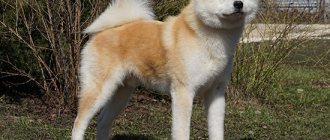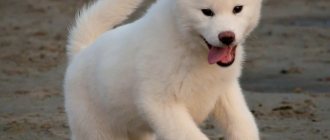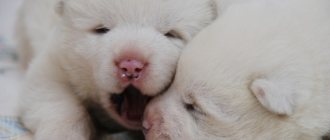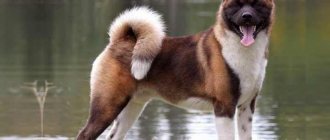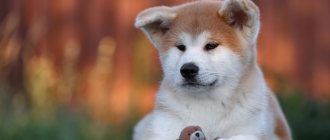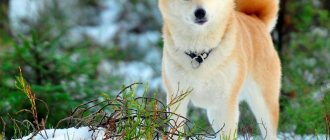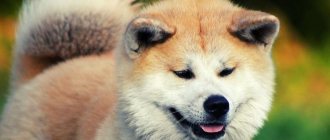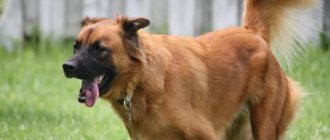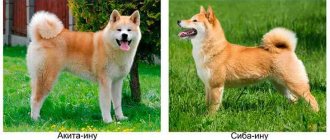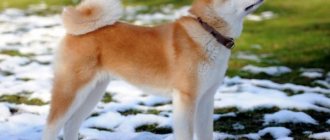At one glance at an Akita Inu dog, a storm of feelings arises that cannot be described in words.
Dogs of this breed are distinguished by their beauty, grace, and nobility.
It is not for nothing that the breed is considered a national treasure of Japanese nature.
If you decide to buy an Akita Inu, you will receive a true loyal friend into the family.
Let's consider the main characteristics of the breed and reviews of owners about their delightful pets.
Description of the breed
The breed appeared in the 17th century in Japan. The Akita Inu was originally used as a hunting or guard dog .
But over time, it received the status of an elite dog; representatives of the breed began to be kept only by wealthy families. And in the middle of the 20th century, the breed spread throughout Europe and the American continent.
According to the standard, the weight of Akita Inu dogs is 32-45 kg for females, 40-45 kg for males, height for females is 58-64 cm, for males - 64-70 cm.
Distinctive external features:
- small almond-shaped eyes of a dark color;
- small erect triangular ears;
- strong large paws;
- large muzzle;
- big strong body;
- curled tail.
Representatives of the Akita Inu breed are among the TOP most beautiful dogs in the world.
The standard allows 4 types of coat color:
- red or fawn;
- with dark ends of hair;
- brindle;
- white.
The main thing in coat color is color clarity and purity. The Akita's coat is quite soft and thick, its length is approximately 5 cm.
The standard color includes uragio - white fur on the face and inner surface of the body..
The life expectancy of representatives of the breed is on average 10-12 years.
Popularity of the breed
Today we cannot say that this is a very fashionable dog. Its representatives are quite rarely seen at venues, which is understandable. A large animal with thick and dense fur is not particularly suitable for apartment keeping. However, cottage owners and residents of the private sector pay close attention to them. The dogs owe this not only to their charming appearance, but also to the strength of their character. There is no creature in the world that is more restrained and reasonable, and at the same time brave and very obedient, so say the reviews of the owners. Akita Inu were once chosen by Japanese samurai. They believed that representatives of this breed could be a worthy reflection of them.
Advantages and disadvantages
To choose a pet, you first need to weigh the pros and cons. Let's look at the possible positive and negative qualities of the Akita Inu breed.
Among the advantages of the breed are::
- fearless character;
- a dog that protects your family;
- infinitely devoted to the owner;
- amenable to education;
- get along well with children;
- do not make noise, do not bark for no reason;
- ready for life both in an apartment and on the street;
- clean and tidy;
- do not have gluttony;
- They have an interesting character and emphasized individuality.
The following features of the dog may be disadvantages for some owners::
- the strength and dexterity of a pet without proper training can have dangerous consequences;
- training should be based on friendship and mutual understanding; it is impossible to force them to follow commands;
- show aggression towards other large dogs;
- rancor towards offenders;
- shedding occurs 2 times a year and requires additional hair care;
- hyperactivity in childhood.
Dog character
Akita Inu is the embodiment of canine devotion and courage. Their character is consistent with the best eastern traditions and is characterized by restraint and balanced temperament.
It seems like nothing can piss these dogs off. This is partly true, but when it comes to the safety of their family, for which the Akita Inu has boundless tender feelings, the dog will show itself in the most unexpected capacity.
It is great for home security . The dog does not like to bark in vain, but if the four-legged friend gives a voice, the house or family members are in real danger.
The character of this amazing dog changes as it grows.
It is important that the breed’s childhood is prolonged, and all individuals under 2 years of age . At this age, Akita behaves as a child should - there is no limit to her curiosity and pranks.
Over time, the dog gains intelligence and wisdom, shows its independent character and becomes more restrained. However, underneath the external equanimity and independence lies a good-natured and loving friend, for whom nothing is more important than the owner and his family.
Who is the breed suitable for?
The dog gets along well with both a large family and a single person. Akita will also make friends with children and even become a nanny for them.
Ideal companions for her are people with an active lifestyle who love sports and travel.
Since the dog needs sufficient physical activity , it will become a wonderful companion for evening or morning runs and energetic recreation in nature.
Intelligence
This Japanese breed is distinguished by its lively and phenomenal intelligence , which has no equal. They have excellent memory, which allows them to remember commands with ease.
Many owners note that dogs remember and well capture the owner’s facial expressions, are sensitive to his mood and are able to adapt to him depending on the situation.
The Akita is not deprived of cunning, which, in its perfection, strives for human cunning. If she does not want to fulfill a particular request, she will definitely try to distract her master. That is why she requires an unwavering and determined owner .
Socialization
She is prone to dominance over other animals, which is why early socialization is so important for her. If a dog grows up with other relatives and cats, there is a high probability that in adulthood it will be much more tolerant and friendlier towards them.
The dog treats guests and strangers with caution, but does not show aggression . Akita is friendly and attentive with children; you can leave the dog alone with them without fear.
Training and education
Start training your pet from an early age so that the puppy immediately feels his place in the hierarchy and does not try to take the place of the leader. At the same time, you should not show rudeness or physical force - the dog does not tolerate disrespect for itself, and will not listen to someone who does not perceive it as a friend, an equal. Gradually teach your dog respect for family members and other pets.
Despite the intelligence and intelligence of the Akita, training can result in problems for those who have not previously dealt with raising large breeds of dogs. This proud and wayward dog requires a special approach .
If you decide to raise it yourself, but have no previous experience, it is advisable to take training courses that will make communication with your pet easier.
It is very important to motivate the dog to succeed, and in this case the reward system works very well. If the pet does not see a reason why it will carry out a particular command, it will simply turn around and leave. Do not infringe on your pet, give him the right to choose , and then Akita training will be successful.
If your puppy is causing trouble, react immediately and report your dissatisfaction in a serious tone.
How active? What kind of people is it suitable for?
A special feature of the breed is that the puppy age is up to 2.5 years. During this period, the dog is infinitely active and playful. However, with age, the Akita acquires such qualities as restraint, independence and calmness.
Representatives of the breed have a good disposition and can even be nannies for children..
They get along well in a large family, but the Akita Inu is also an excellent companion for lonely elderly people.
A pet of this breed is not suitable for people whose families already have pets, since the Akita always shows itself as a leader and can begin to conflict with other pets.
History of the breed
Since we touched on the times of the Japanese emperors, we’ll tell you about the history of these dogs. From reliable sources it becomes clear that Akitas were used as guards for the emperor. This is the result of an excellent hunting instinct and qualities that nature has endowed the dog with. They are self-possessed and fearless, smart and obedient. The breed is very interesting, its history goes back centuries. Moreover, these are not speculations, but real facts based on a genetic study of the remains that were found on the territory of the modern Land of the Rising Sun. The origin of the breed dates back to the second millennium BC. This is confirmed by drawings made around the same time. The image of the dog was finally formed in the 17th century and has remained unchanged to this day.
Who to choose - a boy or a girl?
There is no definite answer to this question; difficulties can arise with both Akita girls and boys.
The girl is soft and flexible and will require more attention and care from you . It will be difficult during the period of female estrus, when the character will radically change.
The male exhibits the qualities of a true hunter and protector of the home . You will need to devote more time to training, walks and active games with your male pet.
In addition, male dogs can be aggressive towards other dogs and cannot tolerate competition from pets.
Therefore, if you have other little pets in the house, it is better to give preference to calmer and more patient girls..
Breed standard
In the entire appearance of the Akita Inu, nobility and power are felt. The refined appearance is harmoniously combined with a dense physique; such a dog commands respect. The exterior of the Akita is so original that it can be compared to a bear, a fox and a wolf. The dog is at the same time similar to the listed animals, this similarity is facilitated by small ears, small eyes and the hollow between them, extending far onto the wide forehead.
The Japanese dog belongs to the Spitz breed and is considered the largest representative in this family. The height of adults is 62-68 cm . with a weight of 40-50 kg .
A short, thick, muscular neck holds a large, slightly blunt head with a flat skull. The erect, triangular-shaped ears are slightly rounded at the ends, with a slight slope towards the eyes. They are quite small compared to the voluminous head. The eyes are dark brown, small in size, not protruding.
The build is large and heavy. The back is flat, slight folds are allowed on the skin. Well developed, deep, wide chest. The front legs are straight, powerful, the hind legs are strong and muscular. The large and fluffy tail is slightly curled and thrown over the back.
According to the standard, the coat should consist of three layers:
1. The top layer is the coarsest and longest hair. 2. The middle layer is hard, not as long as the top hair. 3. The bottom layer (undercoat) is thick and soft.
Excludes coats that are too short and too long.
Whatever the color, it must be clear and clean. Existing spots only have a clear outline. The undercoat may differ slightly in color from the coat. The following colors are allowed:
1. Brindle – white, black or red color may be present. 2. Red - complemented by white spots. 3. White - not a single spot on the coat is allowed.
Good or evil?
There is an opinion that representatives of the breed are aggressive and disobedient, but this depends on many factors.
The purebred breed (Japanese Akita) is not prone to such behavior and is distinguished by its kindness, loyalty, and loving nature..
Also, upbringing and attitude towards a pet plays an important role in shaping its character.
Akita Inu puppies
Interesting fact: a dog's name depends on the size of his mother's litter. If this is the first birth, then the nicknames are chosen with the letter “A”, if the second - with “B” and so on. Read more about nicknames for female dogs and nicknames for male dogs.
In the first weeks after birth, puppies feed exclusively on mother's milk and gradually the breeder adds complementary foods. You can buy an Akita no younger than eight weeks of age. By this time, his diet is replenished with food or natural products.
Choosing a puppy
If you want to buy an Akita puppy, you don't have to go to Japan. In order to choose a friend for yourself and your family, just contact Russian nurseries. All breeders are controlled by curators who monitor the purity of the breed, so the risk of encountering a non-purebred dog is low. However, it is worth deciding in advance not only the gender of the future pet, but also carefully studying the breed standards.
Already at 2 months of age, the main characteristics of the breed appear - erect ears, curled tail, color and width of the skeleton. Knowing the main distinguishing features, you can choose a true Japanese Akita.
Pay attention to the puppies' behavior. With a playful and mischievous disposition, these are the real Akitas. As dogs grow up, they become more reserved, but as children they are active and curious. A modest and quiet puppy is not the best representative of the breed.
Akita Inu price
Since the real Japanese Akita Inu is a fairly expensive and rare breed, you are unlikely to be able to buy a puppy for less than 45,000 rubles. The cost depends on the title of the parents, as well as the place of birth of the puppy. Litter brought from Japan is very expensive. The cost of puppies from parents with awards ranges from 60 to 70 thousand rubles.
Attitude towards children
Akita Inu shows a sensitive attitude towards children and is their protector. The pet will be an excellent companion for children over 8 years old.
NOTE!
In order for an Akita to be a good friend for a child, it is necessary to carry out socialization and education from the first months of the puppy’s life.
It is also important to carry out educational activities with the child, telling him how he can and cannot treat an animal, and what the consequences of an incorrect attitude may be.
In ancient Japan, the breed was considered a nanny even for small children, however, you should not leave children with a dog unattended, even if you are sure that the pet will not harm the child.
Without meaning to, an Akita may be frightened by sudden movements and noise from the baby and perceive the actions as aggression.
If a baby appears in a family that already has an Akita, it is important to continue paying attention to the pet in order to instill in him a good attitude towards the child, otherwise the dog may show attacks of jealousy.
With the right approach you will get the perfect nanny.
Feeding
The larger the breed, the faster its growth rate, which means the more attention you need to pay to your pet’s nutrition during puppyhood. You cannot accustom him to eating from your table. The best option would be properly selected dry food. But while the puppy is growing, it is recommended to combine dry food with traditional food. You won't notice how your Akita Inu grows. A male dog who has just turned 4 months old gains 70% of the height of an adult dog. Of course, the school will still spread out, but the dog already looks impressive. However, for development to proceed correctly, you need to include cottage cheese and lean meat, kefir and broth in your diet every day.
How picky is she about feeding?
Akita Inu is quite unpretentious in feeding. To maintain health, you can give your pet vitamins and monitor its weight.
An adult active dog is fed 2 times a day.
The following foods should be included in your natural diet::
- cereals (rice, buckwheat, oatmeal);
- lean meat (veal, beef, chicken, rabbit);
- vegetables;
- fish;
- dairy products.
CAREFULLY!
It is forbidden to give Akita bones, flour products, potatoes and sweets.
Dog care
Akita Inu does not require special care, but it is important to follow the rules that will allow the dog to remain beautiful, healthy and cheerful.
Thick, beautiful coat that sheds heavily twice a year. To avoid tangles and keep the coat neat, you need to brush it twice a week. During the molting period, it is worth increasing the procedure to three to four times a week.
You should bathe your dog no more than two or three times a year or when it gets very dirty.
Ears and eyes should be kept clean, the mouth should be examined and the teeth should be brushed with a special toothpaste.
In general, the Akita Inu is a very clean breed that does not even have a characteristic odor. If a pet lives in an apartment, then it will patiently wait for a walk to satisfy its natural need.
Maintenance and walking
An Akita will be able to get along both in a private house and in an apartment, with the condition of daily walks in the fresh air. In the apartment, provide the dog with a place where he can be alone.
Don't let your dog sleep on your bed, but allow him to be near you. For discipline purposes, many owners advise limiting the dog's access to the kitchen and bedroom.
In a private house or cottage, a pet can live in an aviary or a large booth, which is preferable for the breed.
The dog's powerful muscles require daily exercise. The dog is full of energy , which must be spent on games and running. A bored Akita is like a tornado that destroys everything in its path.
Without sufficient load, the dog's character deteriorates - it becomes stubborn, assertive, and difficult to train.
Nutrition and health
When feeding this breed, it is necessary to remember its East Asian origin: food that is familiar to us may turn out to be exotic for a pet, and vice versa.
In particular, you should not include chicken or beef in your diet - your dog may develop an allergy. But your pet will like venison or elk meat, if you can find it.
Very young dogs eat five times a day, then, as they grow older, the portions should increase, and the number of meals per day should decrease. Puppies should have in their diet:
- boiled veal,
- skim cheese,
- sea fish,
- rice porridge.
Due to the unusual eating preferences of this individual, experts recommend gradually introducing into the diet a special dry food with a protein volume of no more than 25%, and fat in the range of 12-19%.
Please note that Japanese dogs do not digest soy at all, which is so rich in regular supermarket food. In any case, when purchasing from a puppy, consult a specialist about the diet and diet of your new family member. At first, follow the recommendations given to you, which will greatly simplify the process of acclimatization of the dog.
For an adult pet, the best source of carbohydrates is rice porridge, which should never be replaced with wheat or corn. The inclusion of salted fish, flour products and sweets, as well as smoked meats and sausages . All these foods can cause serious digestive diseases in your “Japanese”.
The Akita Inu is a fairly healthy dog and is not susceptible to serious complications after a rainy walk or sleeping in a draft. Its high level of endurance allows it to overcome long journeys without difficulty, making it an indispensable companion on hiking trips. However, like every large dog, it has a number of specific diseases, so it is advisable to take care of their prevention.
First of all, this concerns problems with the thyroid gland and adrenal glands . To prevent your dog from having problems with this, periodically add iodine-containing foods, such as seaweed, and vitamins to his food, which can be purchased at a qualified pet store.
It is important to remember that Akitas tolerate anesthesia and narcotic analgesics very poorly, and some of them, due to the small number of red blood cells in the blood, cannot be donors for their relatives.
Training and education
One of the most important aspects of raising an Akita is learning to obey its owner. From the first days, show the puppy that you are the master of the house and your word is law. Representatives of the Japanese breed are distinguished by their desire for dominance; this feature must be taken into account during education and socialization.
You may be interested in our article: Raising a puppy. Where to start and how to succeed
Possessing intelligence and intelligence, the Akita Inu is capable of learning. She remembers commands quickly and, with proper training, is ready to carry them out quickly. But the training process itself can be quite lengthy due to the stubborn and wayward nature of the pet.
We need to find an approach to each animal. Aggression and physical punishment on the part of the owner will not help the matter. It is necessary to establish trusting contact between the dog and its owner. The training process is based on mutual understanding. A dog trainer can teach all the subtleties of raising a dog; under his guidance, training lessons will be more effective. Especially when it comes to a dog like an Akita Inu.
Interesting facts about the Akita Inu breed
- The Japanese dog loves to chase other animals even in cramped spaces.
- It is not recommended to look straight into the eyes of an Akita for a long time; this can be perceived as aggression on the part of a person, especially if it is a stranger.
- In rare cases, a training course can be completed successfully without the help of an experienced dog handler.
- An Akita is called a puppy until the age of two.
- Akita Inu is a favorite breed of Japanese samurai, who believe that these dogs are worthy of being their reflection.
- When hunting, Akita Inu behaves like a tiger. It pursues prey in complete silence, presses its body to the very ground and, at the right moment, attacks without barking or roaring.
